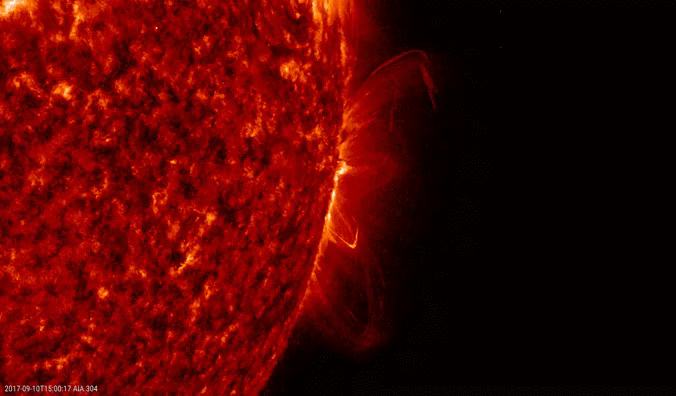With the X9.3 flare on 6 September and the X8.2 event 4 days later, complex sunspot group NOAA 2673 was the source of the two strongest flares of solar cycle 24 so far. The imagery underneath (created with JHelioViewer) provides some additional information on these events.

The X9.3 flare peaked on 6 September at 12:02UT. The above images show the SDO/HMI ("white light") on the left, and difference images (one HMI image subtracted from the previous) on the right from 11:00 till 13:00UT. Detailed examination of these images show the flare in white light between 11:55 and 12:01UT, making this a rare white-light flare (WLF). The famous Carrington flare back in 1859 was also such a WLF, and there have been only about 100-200 such WLFs observed since then, with solar satellites increasing this number significantly (high cadence observations above the earth's atmosphere). Contrary to the Carrington WLF, which consisted of 2 bright dots, the X9.3 WLF consisted of 2 diffuse ribbons along the magnetic polarity inversion line, i.e. a virtual line separating sunspots of opposite magnetic polarity.

The X8.2 flare peaked on 10 September at 16:06UT, when NOAA 2673 had just rotated over the western solar limb. Yet, impressive, compact and bright post-flare coronal loops developed shortly after the flare. The SDO/AIA 171 images on the left show the flare at temperatures around 700.000 degrees (lower corona), whereas the SDO/AIA 1700 images show the event at temperatures of just a few 1000 degrees in the chromosphere (the Sun's lower atmosphere).

These loops endured nearly a full day, as can be observed in the above SDO/AIA 304 imagery covering 21 hours starting on 10 September at 15:00UT. Here the X8.2 event is shown at temperatures around 80.000 degrees (transition region). There's a remarkable resemblance with the flare of 19 July 2012, which produced loops of a very similar shape (see e.g. news items here and especially here for the iconic images). The source region, NOAA 1520, would go on to produce the Carrington-like event on 23 July 2012. The day after the X8.2 event, on 11 September, numerous amateur solar observers were able to observe the still present loops with their small H-alfa telescopes in the red part of the solar spectrum (see also GONG).

Though NOAA 2673 is now transiting the Sun's far side, it remains active. On 17 September, it produced another quite strong flare (estimated between M4 and X1, so not as strong as the X9 and X8 flares) associated with an impressive coronal wave crashing into a coronal hole. This can be seen in the STEREO-A movie above, with extreme ultraviolet images to the left, and difference images to the right to highlight the subtle details. The coronal hole is the darkgreen elongated structure in the upper-right solar quadrant, NOAA 2673 is the active region in the middle of the eastern solar hemisphere. It appears space weather forecasters need to keep an eye on this bad boy when it will return around 24 September.





